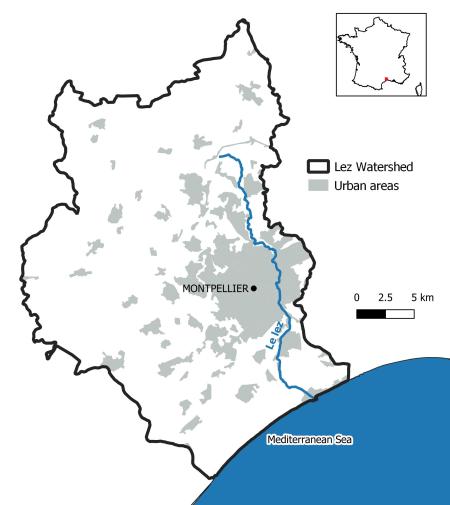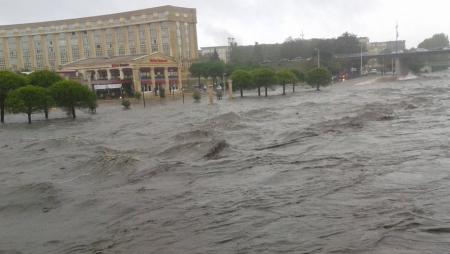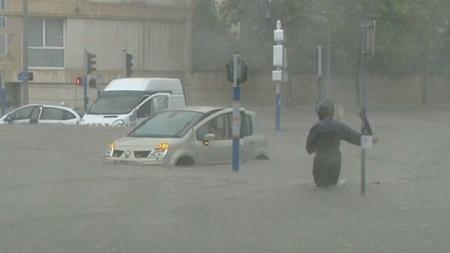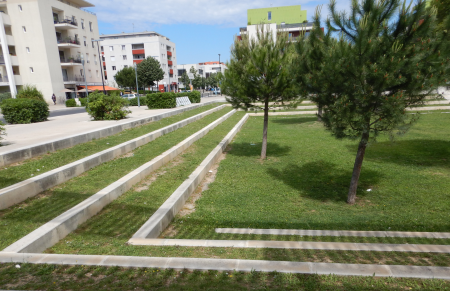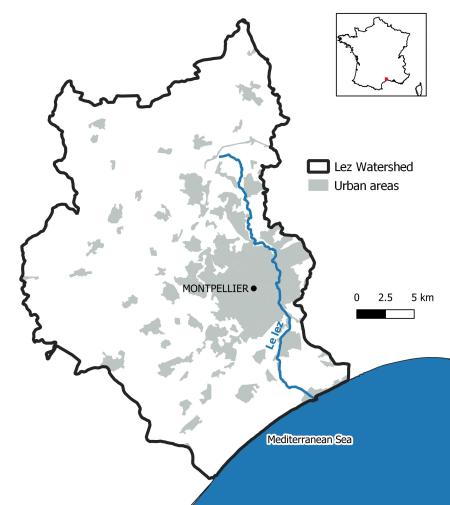
Objective:
The Lez river (29 km long) is a small coastal Mediterranean river with a watershed of 746km2. Its spring is the outlet of a large karst aquifer. It then crosses natural and agricultural areas before reaching the plain of Montpellier (with 290 000 inhabitants) and the Mediterranean Sea. The Montpellier plain is characterized by a rapid urbanization with massive land artificialisation and soil-sealing (2920ha decrease of agricultural and natural areas from 1990 to 2012).
The watershed is exposed to a typical Mediterranean weather marked by repeated droughts and heavy rainfalls and storms in very short time scale in autumn, the so-called “Cevenol events”. These events generate flash floods of the Lez and its tributaries as well as runoff flooding in urban centres.
In 2014 only, 3 major events led to 65 million euros of damages for private housing and businesses. Large investments have been carried out to manage overflow risk but runoff risk remains a major challenge with 78% of damages in the recent large event of 2014.
Images
Financing:
This project has received funding from the European Union’s Horizon 2020 research and innovation programme under grant agreement No 730497.
NAIAD aims to operationalise the insurance value of ecosystems to reduce the human and economic cost of risks associated with water (floods and drought) by developing and testing – with key insurers and municipalities – the concepts, tools, applications and instruments (business models) necessary for its mainstreaming.
Potential impacts/benefits:
The project evaluates 3 types of Nature Based Solutions:
- Active management of the Karst System: The Karst System from which springs the Lez river is artificially pumped and provides drinking water for 340,000 inhabitants. The decrease of the water table due to pumping during the summer season increases the retention capacity of karst during flood events. This may play as a buffer against flood especially during post-summer rainfall events.
- Conservation of agriculture and natural land through urban planning policies: Urban planning policies allow the conservation of agricultural and natural land which in turn influences flooding risk. Three scenarios of urbanization are studied for the 2040-time horizon:
- A non-intervention scenario in which the population growth remains high and new urbanization mainly relying on individual housing that leads to the artificialisation
- A scenario calibrated on present policies with a limitation of population growth and efforts of densification that leads to the artificialisation of 1600ha
- A very virtuous scenario limitation of population growth and an objective of no additional artificialisation
- Deployment of green infrastructure (GI): green infrastructure increase water retention and reduce runoff risk within urban areas. We particularly study:
- deproofing of existing impervious area to restore water infiltration,
- permeable pavements,
- bioswales,
- green roofs,
- open retention basins,
- and rain gardens.
Actions:
The project aims at evaluating the costs and benefits of these NbS in order to support decision makers at the municipality level in the decision to integrate NbS in their development plan.
Concretely, we use spatial modelling to predict three possible scenarios of urban development for the 2040-time horizon. In each of these scenarios, we determine places where green infrastructure could be developed and their possible extent. We obtain six different possible visions of the Lez Watershed in 2040. For each of these visions:
- We estimate the cost of investment and maintenance of NbS,
- With a physical model we evaluated the impact of NbS on floods and we estimate the reduction of damages they may bring in extreme events,
- We estimate the diversity of co-benefits (air quality regulation, reduction of temperature in cities, carbon storage to mitigate climate change) and we try to estimate the monetary value of these co-benefits,
- We finally compare cost and benefits to determine which vision is the most interesting for the society as whole.
Participation of stakeholders is a cross-cutting characteristic of the overall assessment approach. They are mainly involved in the identification of NbS to evaluate and the determination of an implementing strategy and of potential business models for NbS development.
SimUrba is an urban model developed by the University of Montpellier (Calvet et al., in press). Its objective is to simulate urbanization according to population growth and rules for the establishment of new urbanizations. The urban sprawl modeling is based on three main steps:
- Estimation of needs in terms of building areas based on demographic projections at the municipality scale, and an analysis of past trends in terms of building density (in square meters per inhabitant) and urban sprawl: In the simulation of urban areas, we take into account all the built areas including residential and non-residential areas, roads, and public spaces.
- Selection of cells to be built: Depending on the chosen urbanization scenario (the model selects the most interesting cells to be urbanized according to different criteria: the distance to infrastructures (road, bus stop, etc.), services (hospitals, schools) and amenities (natural parks, etc.). In addition, the model considers the ecological importance of the cells based on existing work by ecologists who have mapped an ecological indicator of the biodiversity’s richness in terms of species and habitats. The model favors the urbanization with the lowest indicator of biodiversity. It also integrates local urban planning schemes including urban restrictions (e.g. flood risk areas, high ecological values areas, and restricted zones).
- Simulation of urbanization scenarios: the model can set goals in terms of maximum extension of urbanization. This feature gives the possibility to simulate the different scenarios identified during the workshops.
The outcomes of SimUrba will provide an update of land use for 2040 depending on the scenario, which will be an input in the CCR runoff model.
The main result we expect from this work is that stakeholders are aware of the costs and benefits of different NbS and that they integrate NbS in the development plans of the Lez Basin.
Transferability of result:
Urban runoff and flood damages are expected to further increase in the future and the Lez watershed is particularly concerned. Climate change and human activities are also putting strong challenges on cities: increased pollution levels, increased temperature, flood and drought risks. NbS are particularly attractive because of their capacity to respond to a diversity of challenges simultaneously. Reflexion on NbS implementation in a city is also an opportunity to reform urbanism conception. Their deployment requires a reflexion on urban planning in a broad sense such as transportation, green space management, construction norms. Developing NbS can also the occasion to change the risk management paradigm. When grey infrastructures aim to strictly control and hide the risk, NbS look for an integration of the risk in the daily life to involve resilience. In a perspective of climate change, such a strategy is more sustainable.
Dams, dikes, retention basins or pipes systems are costly investments that generally have negative environmental impacts and address only flooding issues. On the contrary, NbS are less costly investments and they have the advantage to generate a multiplicity of environmental and social benefits. However, NbS are not good at managing extreme events that can be extremely strong in the Lez demos. The complementarity of green and grey infrastructure is therefore fundamental to ensure the management of flooding risk.
Lessons learnt:
Urban development and the subsequent conservation of agricultural and natural land as well as green infrastructure can meet numerous challenges of Mediterranean cities, in a climate change context. These solutions may not be cost-effective if unique benefits are considered but are particularly advantageous if the multiplicity of benefits they generate are taken into account. This multiplicity of benefits requires the implementation of cross-sectorial policies, which requires adaptation from local administrations.
Design team:
Partners of the Lez Demo:
- Bureau de Recherche Géologique et Minière (BRGM)
- Caisse Centrale de Réassurance (CCR)
Authors: Philippe Le Coent
Literature: Calvet, C., Delbar, V., Chapron, P., Brasebin, M., Perret, J., Moulherat, S. (in press). Modélisation prospective des dynamiques urbaines et de leurs conséquences sur les dynamiques écologiques. Application à la région Occitanie. Sciences, Eaux et Territoires
Global goals:
-
13. Climate action
NBS goals:
- Developing climate change mitigation
- Developing climate change adaptation
- Improving risk management and resilience
- Nature-based solutions and the insurance value of ecosystems
NBS benefits:
- Developing climate change adaptation; improving risk management and resilience
- Reduce drought risk
- Reduce flood risk
- Reduce risk of damages from drought
- Increase awareness of NBS solution & their effectiveness and co benefits
- Increase stakeholder awareness & knowledge about NBS
- Increase willingness to invest in NBS
- Social learning about location & importance of NBS
- Sustainable development of coastal regions
